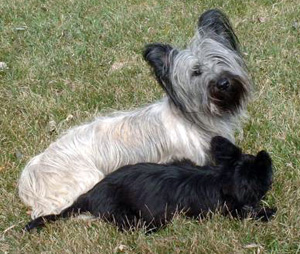
Skye Terrier
Group: Terrier
Origin: Great Britain
Height:
– Male: 10 inches (25 cm) high
– Female: 9 ½ inches (24 cm)
– The length should be twice the height.

Ch. Idrigill An Ivory Peacock (Feather),
with her daughter; Idrigill Castles In The Skye (Phoebe)
Photo credit: Idrigill Skyes
CLICK HERE to View Breeder Listings
Breed Profile
The Skye Terrier, native to the Isle of Skye in Scotland, was bred as a fearless working terrier. He was used to track otter, badger and fox. It is generally believed that the Skye Terrier is the oldest of the Scottish Terriers dating back to the sixteenth century. Today’s Skye, Cairn, Scottish, and West Highland White Terriers evolved from these original hardy, little terriers.
The Skye is a sturdy breed who is twice as long as he is high and his ears are either prick or drop. Originally, the drop-eared variety was favoured when the Skye was used as a working Terrier but, by the 19th century, the prick-eared variety became more popular as a pet and show dog.
The Skye’s temperament is described as one with courage, strength and stamina. Although he may be reserved with strangers, he is friendly and good natured with those he knows. Fearless, alert, loyal, and sensitive, the Skye has the temperament of a typical working Terrier. The Skye’s loyalty and devotion runs deep, however, the confidence and respect of a Skye must be earned.
He has a hard, straight, flat outer coat that hangs down to a length of 5.5 inches (14 cm). The hair on the head is shorter and softer with a veiling on the forehead and eyes. He also has a short and soft undercoat. His colour may range from cream to black, preferably with darker ears, muzzle and tail tip.
Health Issues
If you are considering the adoption of a Skye Terrier puppy, or any breed, it is very important to be selective in choosing a responsible and reputable breeder. Ensure that the prospective puppy’s parents have all health clearances. Breeding of any dog should not be done until after they have been proven to be free of evidence of significant hereditary diseases. (For more information on selecting a breeder, see the articles on the main General Information page.)
Additional Health Resources:
- Skye Terrier Foundation Health Survey
- Canine Health Information Center (CHIC) — Providing a source of health information for owners, breeders, and scientists that will assist in breeding healthy dogs. CHIC is a centralized canine health database jointly sponsored by the AKC/Canine Health Foundation (AKC/CHF) and the Orthopedic Foundation for Animals (OFA).
- Health and Nutrition — Growing section of the Canada’s Guide to Dogs website which includes information on several health and nutrition related issues.
- AKC Canine Health Foundation — Working towards developing scientific advances in canine health.
- Canine Eye Registration Foundation (CERF)
- Orthopedic Foundation for Animals (OFA)
- Ontario Veterinary College (OVC)
- University of Pennsylvania Hip Improvement Program (PennHip)
- HealthGene — HealthGene Corporation is the leading provider of veterinary DNA diagnostic services in Canada.
- Labgenvet — Laboratory of Veterinary Genetics is a Canadian diagnostic laboratory that offers a comprehensive service of DNA tests for veterinary genetic diseases.
Grooming Information
The Skye Terrier has a long and luxurious double coat that requires brushing once a week. The coat must be kept groomed or it will mat. Nails should be kept trimmed, ears cleaned and teeth checked and cleaned when necessary.
- Grooming — This section of the Canada’s Guide to Dogs website includes tips, articles and information covering all aspects of dog grooming along with a listing of Groomers from across Canada.
Training Resources
The Skye Terrier is generally reserved with strangers and can often appear standoffish. Early socialization is very important for this breed.
- Training — For training information, see this growing section of the Canada’s Guide to Dogs website for tips, articles, as well as listings of training centres across Canada.
Additional Information
- Clubs, Sports & Activities — For information on the many sports and activities you can get involved in with your dog.
- Working Dogs — The Working Dogs section of the Canada’s Guide to Dogs website provides information and listings of organizations that are involved in various dog jobs, such as Guide Dogs, Therapy Dogs, Police Dogs, Protection Dogs, and much more.
Breed Listing
*NOTE 1: CHIC – The Canine Health Information Center “is a database of consolidated health screening results from multiple sources. Co-sponsored by the Orthopedic Foundation for Animals (OFA) and the American Kennel Club (AKC) Canine Health Foundation, CHIC works with parent clubs to identify health screening protocols appropriate for individual breeds. Dogs tested in accordance with the parent club established requirements, that have their results registered and made available in the public domain are issued CHIC numbers.” To learn more, visit: www.caninehealthinfo.org
*NOTE 2: The Fédération Cynologique International (FCI) is the World Canine Organization, which includes 91 members and contract partners (one member per country) that each issue their own pedigrees and train their own judges. The FCI recognizes 344 breeds, with each being the “property” of a specific country. The “owner” countries write the standards of these breeds in co-operation with the Standards and Scientific Commissions of the FCI, and the translation and updating are carried out by the FCI. The FCI is not a breed registry nor does it issue pedigrees.
Quick Links
Get In Touch
- Email: canadasguidetodogs@gmail.com
- Email: info@canadasguidetodogs.com
- Visit us on Facebook: www.facebook.com/CanadasGuideToDogs
— CanadasGuideToDogs.com is an Amazon Associate as well as a participant in various affiliate programs, as such fees are earned from qualifying purchases.
